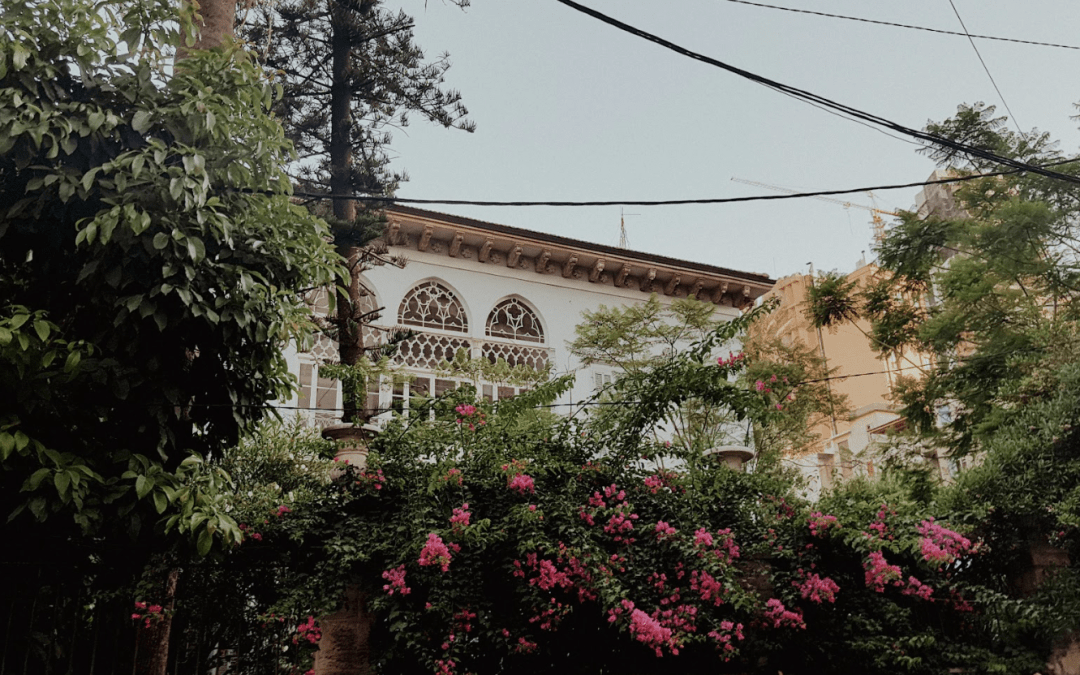By Dina Al-Amood | Staff Writer
Tripadvisor describes Gemmayze as the Greenwich Village or Soho of Beirut. If you’ve strolled through its bars, cafes, restaurants, and galleries, you’ve experienced firsthand why this area, along with its adjacent Mar Mikhaël, constitutes the locus of Lebanese art and the primary social scene in Beirut.
The two districts run along Armenia Street and Rue Gouraud, with Achrafieh to the south and Saifi Village to the west. They’re visually distinct for their French-mandate Art Deco architecture, adorned with vibrant street art and murals.
And who hasn’t been? In fact, if you’re an AUBite or a French-speaking Beiruti, it’s safe to assume you know the ins and outs of the two districts like the palm of your hand. But what’s the deal with Gemmayzeh and Mar Mikhaël? Why do conceptual eateries, high-brow art galleries, and bars crowd in and around them? History can narrate the answer.
For starters, the two districts have not always reigned as the joint cultural epicenter of Beirut. In the 1950s and 1960s, Hamra Street in the Hamra district was known as the Champs-Élysées of Beirut. West of Ras Beirut, the street is enveloped between two of the best universities in the country, the American University of Beirut (AUB) and Lebanese American University (LAU). This naturally contributed to its popularity among the educated middle and upper classes. Hamra’s café culture attracted artists, intellectuals, and political activists of various Arab nationalities. Among them, the secular, Arab nationalist spirit was shared.
By far, there was no place more interesting to spend your Saturday night than Hamra Street. Where else might you see Fayrouz, Dalida, Louis Armstrong, and Paul Anka perform? None other than the Piccadilly Theater in Rue Hamra heard the echoes of all these legendary voices.
Twenty-two cinemas screened the latest Egyptian and Hollywood productions in and around Hamra Street. When the civil war began in 1975, at the peak of Hamra’s bloom, moviegoers continued to catch the latest films at the theater despite the security threats. This went on for the first few years of the war. Later, the battle of militias ignited in Hamra. Many Arab nationalist thinkers were assassinated in its cafes, causing many intellectuals to leave the neighborhood in fear. All other demographics that once frequented Hamra, from middle-class Lebanese families to tourists, also abandoned it. By the end of the war in 1990, virtually all theaters shut down. So too, the cafes and boutiques that made up the cosmopolitan identity of Hamra suffered tremendous economic losses as rent expenses and private electricity generator bills accumulated with little to no revenue to cover them.
In the post-war renovation and revitalization of Beirut, the center of Beirut’s commerce moved from Hamra to downtown Beirut. This was mainly due to the comprehensive reconstruction project led by Solidere, a private real estate company established to reconstruct the city center. The company executed a master plan to transform the landscape of the original downtown area from its traditional architecture into a modern business, residential, and commercial district. The plan included building new infrastructure for the entire district and introduced Lebanon’s first modern high-rises. As a symbol of Lebanon’s economic resurgence, the project attracted billions of dollars’ worth of foreign investment, enabling construction to persist for decades.
Meanwhile, Hamra’s transformation was less centralized than Downtown Beirut’s orchestrated reconstruction. The revitalization of Hamra was driven by incremental initiatives from local business owners, residents, and municipal authorities since foreign investors weren’t convinced of the district’s economic potential. In the early 2000s, new water, sewage, and electricity systems were constructed for the area. Today’s Hamra is home to various independent shops, cafes, and cultural spaces that keep the area busy by day. Still, local shop owners agree its streets feel nothing like the 60s.
The sidewalks of this once-vibrant street now witness the struggles of poverty-stricken Lebanese and Syrian refugees who resort to begging for survival. By nightfall, most shops shut down to save on electricity bills while demand is slow. The street then feels deserted, except for international chains like Starbucks and Nike kept open. Piles of trash accumulate on its corners, pointing to the broader challenges that have plagued Lebanon. The economic crisis has swept through this street, leaving those on its sidewalks with a faint memory of its glorious days.
Still, due to several challenges, Downtown Beirut was not what replaced Hamra as Beirut’s cultural hub despite tremendous investment led by Solidere. First, the grand plan’s focus was on attracting foreign investments, luxury developments, and high-end retail, which shifted the primary identity of the area towards a business and commercial district. This top-down approach to the master plan has also not allowed for the organic growth and authenticity that often characterizes cultural districts. In addition, the rising costs of living and doing business in the area pushed out grassroots artistic and cultural endeavors.
Over time, alternative neighborhoods like Gemmayze and Mar Mikhael gained prominence as cultural hubs. These areas offered a more diverse and grassroots approach to cultural expression, attracting artists, musicians, and creative individuals away from Downtown Beirut.
In the aftermath of the Civil War, they also went through a gradual process of revitalization similar to Hamra’s. Existing structures were used to reconstruct the buildings, preserving the area’s Art Deco architecture. Its aesthetic beauty caused an influx of a younger upper-class demographic into Gemmayze and Mar Mikhael from students to artists and professionals. Artistic entrepreneurs then established independent art galleries, live music venues, and concept stores in what were once warehouses and traditional Lebanese homes. The area’s demographic then began to include expats and tourists attracted to the unconventional urban experience.
The two neighboring areas we’ve circled back to hold the memory of a bygone Beirut, Beirut as the cultural capital of the Middle East. This history tells us any neighborhood in Beirut can be the next Soho if the right pockets and creative minds plant the seeds.


Well written article by a smart and intellectual individual.